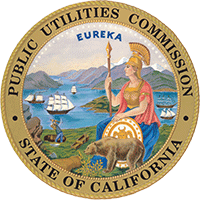Transportation Electrification
The CPUC plays a critical role in supporting the state’s transition to zero-emission vehicles (ZEVs). As regulators of the state’s electric investor-owned utilities (IOUs), the CPUC applies its expertise and experience in electric system infrastructure deployment and planning, grid management, rate design, and safety to support ZEV deployment and integration with the electric system. The CPUC also works closely with other state agencies to ensure our policies and the electric IOU's investments to support ZEVs infrastructures are strategically coordinated and in the interest of ratepayers. The CPUC’s activities on transportation electrification primarily fall into six main categories:
- Electric rates and cost of fueling
- Timely energization of electric vehicle charging infrastructure
- Proactive planning of grid infrastructure to support transportation electrification
- Vehicle-grid integration (VGI) policy, pilots, and technology enablement
- Strategic planning for charging infrastructure deployment and incentives
- Program evaluation and interagency coordination
The CPUC has two open proceedings addressing transportation electrification issues:
- Rulemaking (R.)23-12-008, focused on Transportation Electrification Policy and Infrastructure, and
- R.24-01-018, focused on Establishing Energization Timelines (including those related to electric vehicle infrastructure). More information on the Energization OIR can be found here.
California State Policy on ZEVs
California has established many goals for transportation electrification to accelerate the adoption of ZEVs and increase access to charging stations which guide much of the CPUC’s work on transportation electrification. The tables below summarize several of the key pieces of legislation and Executive Orders that guide our work.
|
Bill |
Sponsor |
Year |
Short Description |
|
De Leon |
2015 |
Clean Energy and Pollution Reduction Act of 2015 |
|
|
Burke |
2017 |
Electric Vehicle Charging Infrastructure: School Facilities and other Educational Institutions |
|
|
Burke |
2017 |
Electric Vehicle Charging Infrastructure: State Parks and Beaches |
|
|
Skinner |
2018 |
California Clean Miles Standard and Incentive Program: Zero-emission Vehicles |
|
|
Lara |
2018 |
Electric Vehicle Charging Infrastructure |
|
|
Ting |
2018 |
Electric Vehicle Charging Infrastructure:Assessment |
|
|
Bradford |
2019 |
Electric Vehicles-Grid Integration |
|
|
Ting |
2020 |
Energy: Transportation Electrification and School Energy Efficiency Stimulus Program |
|
|
Ting |
2022 |
Transportation Electrification: electric vehicle charging infrastructure |
|
|
Wood |
2023 |
Public Utilities: timely service: customer energization |
|
|
Becker |
2023 |
Power Up Californians Act |
|
E.O. |
Governor |
Year |
Short Description |
|
Newsom |
2020 |
Established goal for all in-state sales of new passenger vehicles to be zero-emission by 2035; 100% medium- and heavy-duty vehicles be zero-emission by 2045; for all operations where feasible, and by for drayage trucks; and 100 percent zero-emission off-road vehicles and equipment by 2035 where feasible |
|
|
Brown |
2018 |
Established target five million ZEVs by 2030, and 250,000 public EV charging stations; 10,000 of which should be fast chargers |
|
|
Brown |
2012 |
Established target of one million ZEVs on the road by 2025 |
CPUC Contacts
|
Topic |
Name |
Contact |
|
Interim TE Section Supervisor |
Emmanuelle Truax |
Emmanuelle.Truax@cpuc.ca.gov |
|
Proactive Planning for TE Infrastructure and Freight Infrastructure Planning VGI Policy, Pilots and Planning Medium-and-Heavy-Duty Program Oversight and Evaluation Funding Cycle and Funding Cycle 1 |
Emily Clayton | Emily.Clayton@cpuc.ca.gov |
|
EV Infrastructure Rules and Energization Light-duty Program Oversight and Evaluation Low Carbon Fuel Standard Data Assessment and Reporting
|
Katie Pratt |
Katherine.Pratt@cpuc.ca.gov |
|
VGI Pilot Oversight Low Carbon Fuel Standard EV Rates |
Meschelle Thatcher | Meschelle.Thatcher@cpuc.ca.gov |
|
Research and Evaluation Technical Assistance Program Oversight Energization Proceeding Support |
Allison Hoops | Allison.Hoops@cpuc.ca.gov |
|
PEV Submetering and Telematics VGI Technology |
Shiva Ourang | Shiva.Ourang@cpuc.ca.gov |
How To Participate In Our Proceedings
There are two ways to receive information related to a Commission proceeding:
- Join a proceeding service list to receive e-mails with all documents sent by the Commission, by parties participating in the proceeding, as well as notices of workshops or other events. Visit https://www.cpuc.ca.gov/become_a_party/ for instructions on how to become a party to a proceeding.
- Sign up for the Commission's Subscription Service to follow a particular proceeding, industry, or type of document. Note that you will only receive documents from the subscription service once they have been accepted for filing, so there will be a delay in receiving notification of filed document. Additionally, some types of documents, such as testimony and other communications, are not provided via subscription service and are sent only to the service list.
